How to Make Thai Basil Chicken (Pad Krapow Gai)
Updated: Dec. 06, 2023
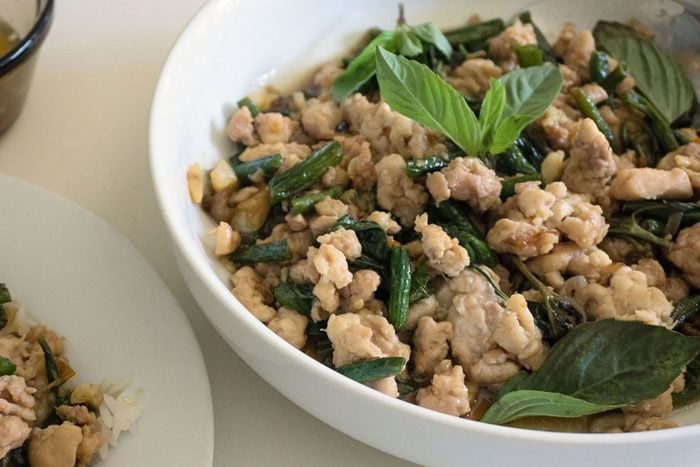
Love Thai basil chicken? It's easy to recreate this Thai restaurant favorite at home. You'll need chicken thighs, a few pantry staples, and aromatic Thai basil.
Aromatics are always the first ingredients I think of when making a Southeast Asian recipe like Thai basil chicken, also known as pad krapow gai. This Thai recipe is a great introduction to incorporating lively herbs in a stir-fry.
Using herbs as aromatics rounds out the overall flavor of certain dishes and creates distinct tastes. Think of oregano and dill in Greek dishes, basil and thyme in Italian dishes and cilantro and basil in Mexican dishes. In Thai cuisine, you’ll often taste coriander root, mint and Thai basil. It’s the latter of these that we’ll work with for this Thai chicken recipe.
What Is Thai Basil Chicken (Pad Krapow Gai)?
Thai basil chicken is a sweet and savory simmering stir-fry that uses a glazed sauce to pull the Thai basil, vegetables and chicken thighs together into a cohesive dish. Served over rice, sometimes with a fried egg and a side of a prik nam pla (a bright and spicy fish sauce), it’s a straightforward meal to make when you are craving a tasty Thai recipe.
Ingredients for Thai Basil Chicken
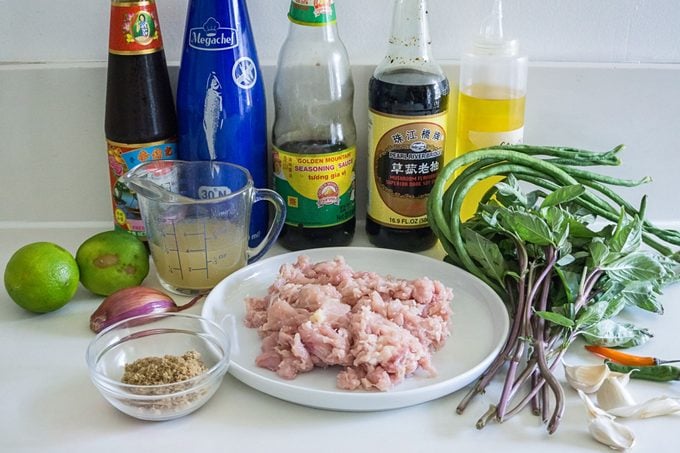
We’ll use quite a few essential Thai ingredients in this recipe. Below are some of the key elements.
Thai basil
There are all sorts of basil variations, but this recipe specifically calls for Thai basil. It’s often described as having a licorice or anise taste with a peppery note, compared to its sibling, sweet basil. If you’ve ever been to a pho restaurant, you might have seen it on your accoutrements plate as it’s a tasty and harmonizing herb to a protein-heavy dish. For culinary usage, you will only need to use the leaf part; the stem can be discarded.
Chinese or “snake” green beans
Chinese or “snake” green beans are a common type of green bean used in Asian cooking that are leaner and longer in size than other green beans. They also have a heartier texture. Aside from a mildly nutty flavor, the overall taste is similar to the average green bean. If you can’t source snake beans, feel free to use any kind of snap pea, green bean or even green bell peppers.
Oyster sauce
Oyster sauce is a necessary stir-fry sauce staple; It gives a rounded sweet flavor and thickness to any stir-fry sauce. Because most Thai stir-fries don’t use starches to thicken the sauce, the oyster sauce is heavily relied on to add that viscosity. An alternative to using oyster sauce would be adding honey.
Fish sauce
Fish sauce is a must for many Southeast Asian recipes, like Thai basil chicken. It adds an extra depth of salty flavor. Fish sauce can now be found at most grocers in the Asian aisle, and there are great vegan and vegetarian options too.
Seasoning sauce or soy sauces
Seasoning sauce and mushroom soy sauce are my personal staples for building a tasty stir-fry sauce. If you are going to dive more into making Asian cuisine, having various types of Asian sauces is important. They all have a function and flavor profile that stand on their own and make a difference to most dishes.
Shallots
Having a variety of onions in the house is important for cooking, as each one has a distinct aroma and taste meant for various dishes. Shallots are small but pack a strong punch, and turn sweet and nutty once cooked.
Thai chilis
These tiny little peppers pack a lot of spice, so be careful when you use them. I recommend starting with half a chili first. Let it cook in the sauce, and taste the sauce before adding more.
Also, if you like experimenting and trying different recipes; dive into this chicken satay recipe with a creamy, peppery peanut sauce for dipping.
How to Make Thai Basil Chicken
Ingredients
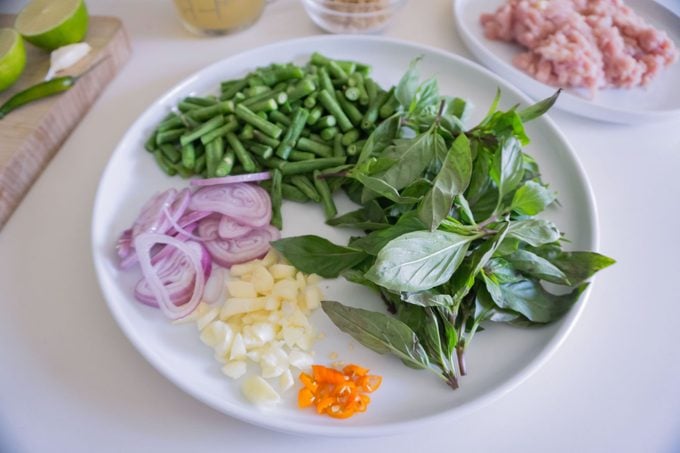
- 2 chicken thighs, skinless
- 2 cups green beans, chopped into 1/4-inch pieces
- 1 bunch of Thai basil leaves (leaves should be plucked from the stem)
- 3 to 4 tablespoons neutral oil
- 1 shallot, thinly sliced
- 3 to 4 garlic cloves, roughly chopped
- 1 to 2 Thai chilis, finely sliced
- 1/2 cup chicken broth or water
Thai Basil Sauce:
- 2 tablespoons oyster sauce
- 2 tablespoons fish sauce
- 2 tablespoons soy or seasoning sauce
- 1 teaspoon mushroom soy sauce
- 1 tablespoon brown sugar
Prik Nam Pla (optional):
- 3 tablespoons lime juice
- 2 tablespoon fish sauce
- 1/2 or 1 Thai chili, finely sliced
- 1 teaspoon brown sugar
- 1 garlic clove, finely minced
Directions
Step 1: Make the sauce
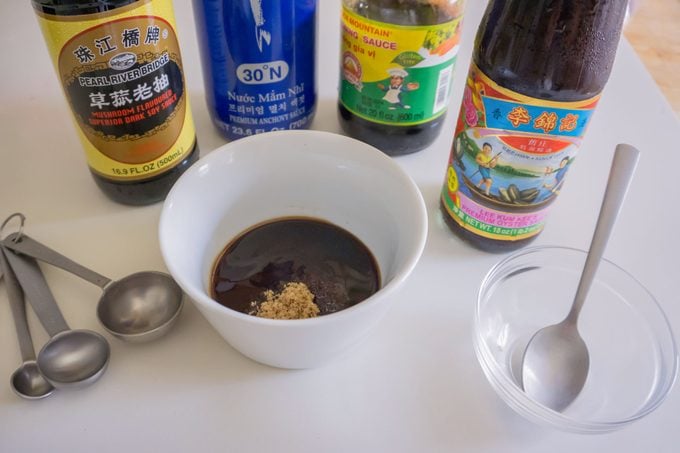
In a small bowl, stir together the oyster sauce, fish sauce, seasoning sauce, mushroom soy sauce and sugar. Set the mixture aside.
If you’re making prik nam pla, mix it together now, too. It’s not used in the cooking process; it’s served as an accompanying sauce with the finished dish.
Step 2: Prep the chicken
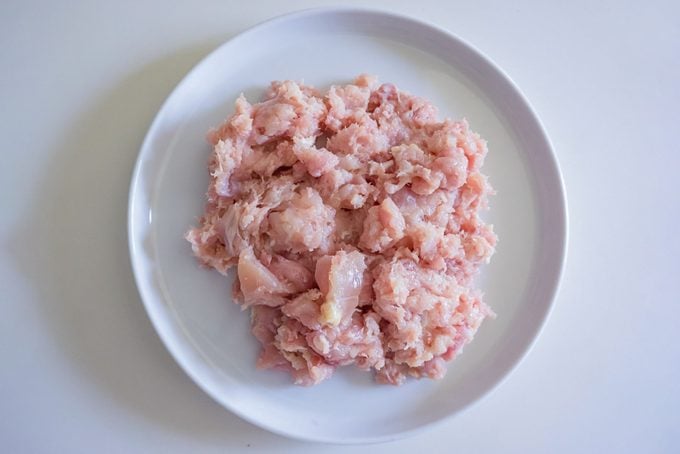
Hand chop or use a food processor to cut your chicken thighs into small pieces. The pieces should be a little bigger than ground chicken. Place the chopped chicken in a bowl and set aside.
Step 3: Cook the green beans
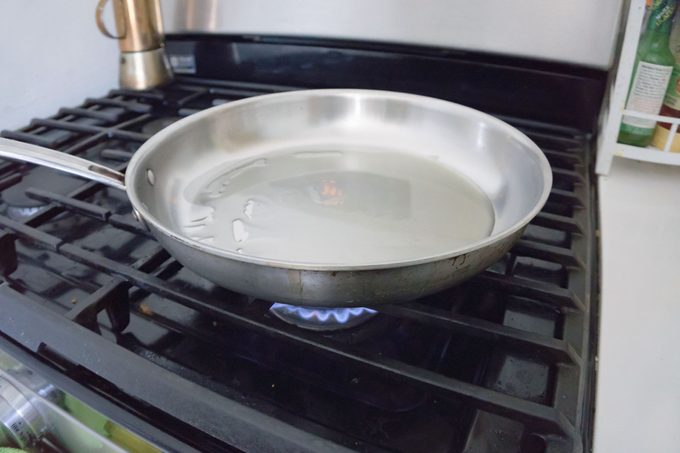
Heat your wok or frying pan to medium-high heat. Add the oil, and when the pan feels hot, add your green beans and shallots. Stir until the shallots release an aroma and soften.
Step 4: Cook the chicken
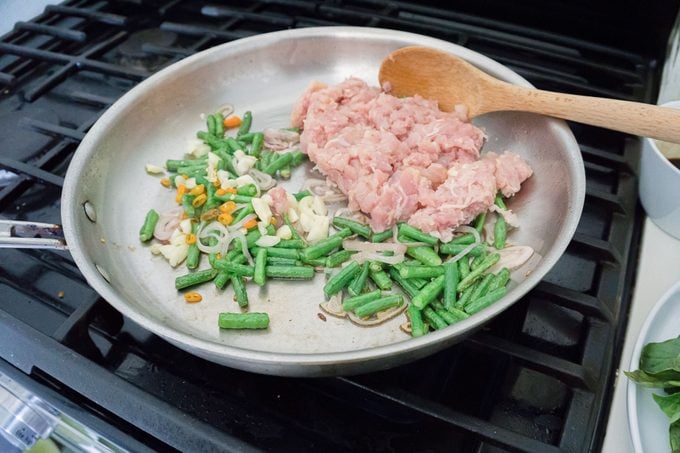
Add the chicken and garlic to the pan. Let the chicken sear for just a few seconds before giving it a stir. Keep stirring gently until the chicken has turned a paler color and is cooked through.
Editor’s Tip: If you prefer crisper green beans, add them to the pan after the chicken is cooked, before adding the sauce.
Step 5: Add the sauce
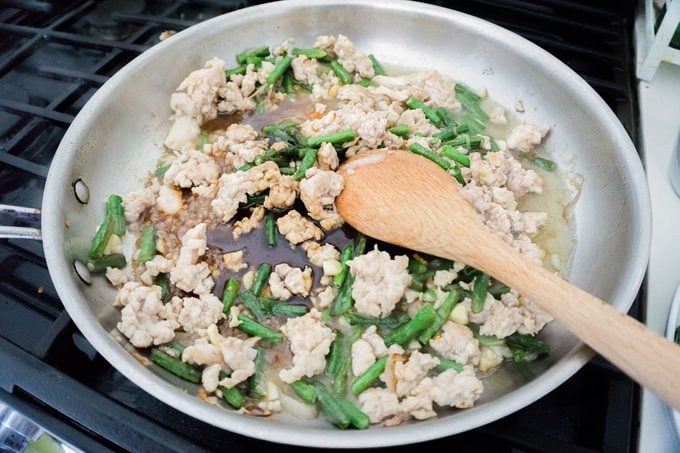
Pour in the sauce you made in step one and the broth (or water). Simmer for three to four minutes, until the chicken and green beans have absorbed some of the liquid.
Step 6: Mix in the basil
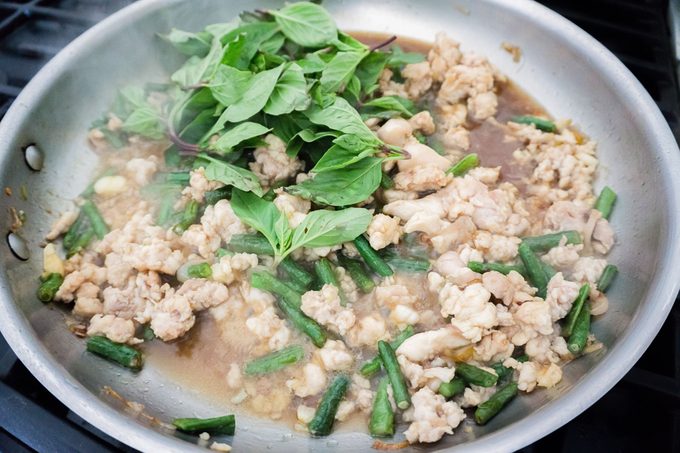
Add the Thai basil and gently toss it with the chicken and green beans.
Step 7: Add the prik nam pla
Serve your Thai basil chicken over a plate of jasmine rice and pour on a little of the prik nam pla if you want to brighten and spice up the stir-fry.
Tips for Making Thai Basil Chicken
How can you tell when the chicken is done?
Check if your chicken is done by using a meat thermometer. it should be hitting between 165 to 175°F. A raw piece of chicken is pink and translucent, and almost oily looking. Once it’s cooked, it becomes paler in color—almost white—and is usually moist and fibrous.
How do you store leftover Thai basil chicken?
Store your Thai basil chicken in an airtight container and separately from your rice, if possible. This stir-fry is very saucy and can leak, so you don’t want any spills in your fridge. The Thai basil chicken will be good for three to four days.
Can you make Thai basil sauce ahead of time?
You can make the sauce ahead of time. The sauce stays fresh in a tightly sealed jar or container for a week. I highly recommend doubling the sauce for an extra saucy Thai basil chicken or to have for other stir-fry recipes you’ll be making during the week.
What do you serve with Thai basil chicken?
Thai basil chicken is often served over white jasmine rice, with a side of the lime-y, spicy fish sauce called prik nam pla. If you don’t have jasmine rice, you can serve it with basmati or cooked rice noodles. Anything starchy that will absorb all that tasty sauce will work!
Some folks love a crispy-edge fried egg over their rice plate. The yolk and creamy egg whites can really balance the richness of the meal.
